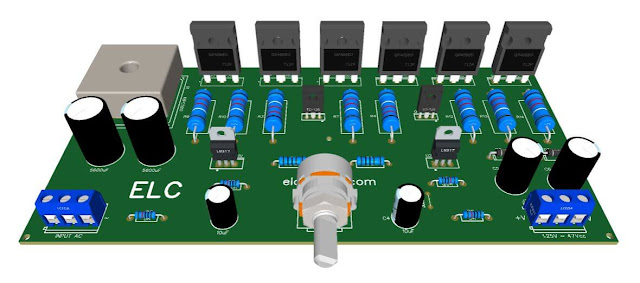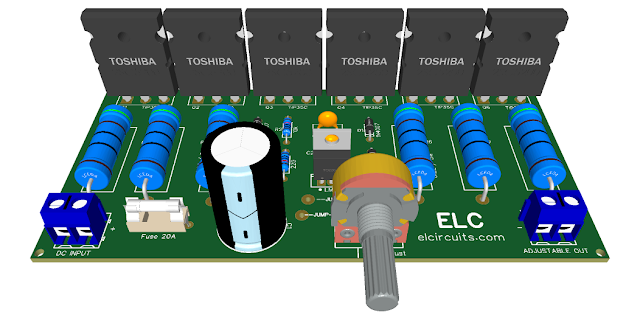You may be interested in:
- Switched Power Supply SMPS 13.8V 10A using IR2153 IC and IRF840, with PCB
- Adjustable Power Supply 1.5V to 28V, 7.5 Amps With IC LT1083 + PCB
- Symmetrical Adjustable Power Supply 1.25V to 47V 10 Amps with Short Circuit Protection + PCB
- Adjustable Switching Power Supply 5.1 to 40V, 2.5 Amp using L4960 + PCB
- Adjustable Power Supply 1.2 to 37V High Current 20A with LM317 and TIP35C + PCB
- Adjustable Power Supply 1.25v to 57V, 6 Amps with TIP36C + LM317HV + PCB
- Adjustable Power Supply 1.25v to 33V, 3 Amps with LM350 + PCB
- Stabilized Power Supply 13.8V High Current 10 Amps with PCB
How the circuit works
Formula 1st Ohm's Law
- V - Voltage or electric potential
- R - Electrical resistance
- I - Electrical current
Calculating the load resistors
- V = R * I
- V = The cut-off voltage of transistors Q2 and Q3 TIP36C is 0.6V. This is the cut-off range of the transistor. Let us call Q2 and Q3 of Qeq
Then:
- R1 = Vbe_Qeq / I_CI1
- R1 = 0.6V / 0.6A
- R1 = 1 Ohm
Calculation of the protection circuit resistance
- V = R * I
- V = The cut-off voltage of the transistor Q1 is 0.6 V. "This is the cut-off range of the transistor".
- I = The total current of the power supply, which is 6A.
Then:
- R1 = Vbe_Q1 / I_ps
- R1 = 0.6V / 6A
- R1 = 0.1 Ohm
Current of the power transistors
- P = 5V * 25A = 125W.
- Pmax = V * I:
- Imax = P / V = > Imax = 125W / 37V = > Imax = 3.37A
- How are two transistors together Imax = 6,74A
 |
| Fig. 2 - Schematic diagram Adjustable power supply circuit with short circuit protection |
Components List
- CI1 ................ Voltage Regulator LM317
- Q1 ................. PNP Transistor BD140
- Q2, Q3 .......... Power Transistor PNP TIP36C
- D1 ................. Bridge Rectifier 50A - KBPC5010
- D2, D3 .......... Rectifier Diode 1N4007
- R1 ................. Resistor 2W / 1Ω
- R2, R4, R5 ... Resistor 5W / 0.1Ω
- R3 ................ Resistor 1/4W / 220Ω
- C1 ................ Electrolytic Capacitor 5600uF - 50V
- C2, C3 .......... Polyester/Ceramic Capacitor 0.1uF or 100nF
- RV1 .............. Potentiometer 5KΩ
- P1, P2 ........... Screw Terminal Type 5mm 2-Pin Connector
- Others .......... Wires, solders, printed circuit board, etc.
Download
We provide the files with the PCB, the schematic, the PDF, GERBER and JPG, PNG and provide a direct link for free download and a direct link, "MEGA".
Click on the direct link to download the files: Layout PCB, PDF, GERBER, JPG
If you have any questions, suggestions or corrections, please leave them in the comments and we will answer them soon.
Subscribe to our blog!!! Click here - elcircuits.com!!!
My Best Regards!!!

















